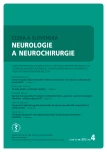The Computer-Assisted Quantitative Sensory Testing – Normative Data
Authors:
Š. Buršová1ihash2ihash4ihash6ihash8 ,2 ,2 ,2 ,2 ,2
Authors‘ workplace:
Neurologická klinika LF MU a FN Brno
1; CEITEC – Středoevropský technologický institut MU, Brno
2
Published in:
Cesk Slov Neurol N 2012; 75/108(4): 444-453
Category:
Original Paper
Overview
Introduction:
Detection of thermal (TPT) and vibratory (VPT) perception thresholds using the computer-assisted quantitative sensory testing (QST) is currently one of the most important methods for diagnosing sensory neuropathies. The aim of the study was to establish valid, age-stratified normal limits for both the QST methods.
Patients and methods:
Findings from 88 (TPT) or 74 (VPT) healthy individuals provided the basis for establishing age-stratified normal values in subgroups of patients aged 20–40, 40–60 and 60+ years.
Results:
Slight but significant differences between men and women and highly significant age-related changes were found for all the TPTs and VPTs with lower cold thresholds and higher warm and vibratory thresholds in men and in older individuals. Using the method of limits, lower normal values for cold TPT were set at 26.3–25.5–22.8 °C for the respective age subgroups of men and 29.1–26.6–21.1 °C for the respective age subgroups of women. Similarly, upper normal limits for warm TPT were set at 40.8–44.9–46.2 °C, respectively, in men and 39.5–41.2–48.2 °C, respectively, in women, and at 6.0–12.5–50.3 μm, respectively, in men and 4.0–13.2–33.6 μm, respectively, in women for VPT. Threshold values also depend on the testing algorithm used, with slightly higher values in reaction time inclusive methods (Limits) compared to reaction time exclusive algorithms (Levels).
Conclusions:
Cold and warm TPT as well as VPT display significant age-effect and less significant effect of gender on perception threshold values. The evaluation of the VPT and TPT findings in patients with sensory neuropathies should thus be performed using the age- and gender-adjusted normal values for particular testing algorithm.
Key words:
sensory neuropathy – small fiber neuropathy – quantitative sensory testing – thermal perception threshold – vibratory perception threshold – normative values
Sources
1. Cruccu G, Sommer C, Anand P, Attal N, Baron R, Garcia-Larrea L et al. EFNS guidelines on neuropathic pain assessment: revised 2009. Eur J Neurol 2010; 17(8): 1010–1018.
2. Haanpää M, Attal N, Backonja M, Baron R, Bennett M,
Bouhassira D et al. NeuPSIG guidelines on neuropathic pain assessment. Pain 2011; 152(1): 14–27.
3. Rolke R, Baron R, Maier C, Tölle TR, Treede RD, Beyer A et al. Quantitative sensory testing in the German Research Network on Neuropathic Pain (DFNS): standardized protocol and reference values. Pain 2006; 123(3): 231–243.
4. Rolke R, Magerl W, Campbell KA, Schalber C, Caspari S, Birklein F et al. Quantitative sensory testing: a comprehensive protocol for clinical trials. Eur J Pain 2006; 10(1): 77–88.
5. Moravcová E, Bednařík J. Počítačem asistované stanovení termického prahu. Cesk Slov Neurol N 2003; 66/99(4): 263–269.
6. Hilz MJ, Axelrod FB, Hermann K, Haertl U, Duetsch M,
Neundörfer B. Normative values of vibratory perception in 530 children, juveniles and adults aged 3–79 years. J Neurol Sci 1998; 159(2): 219–225.
7. Chong PST, Cros DP. AAEM review: quantitative sensory testing equipment and reproducibility studies [online]. Dostupné z: http://www.aanem.org/getmedia/2621cf05-81e1-416e-b2eb-75282234972a/qstTechniques.pdf.aspx.
8. Peters EW, Bienfait HM, de Visser M, de Haan RJ. The reliability of assessment of vibration sense. Acta Neurol Scand 2003; 107(4): 293–298.
9. Perry SD. Evaluation of age-related plantar-surface insensitivity and onset age of advanced insensitivity in older adults using vibratory and touch sensation tests. Neurosci Lett 2006; 392(1–2): 62–67.
10. Van Deursen RW, Sanchez MM, Derr JA, Becker MB,
Ulbrecht JS, Cavanagh PR. Vibration perception threshold testing in patients with diabetic neuropathy: ceiling effects and reliability. Diabet Med 2001; 18(6): 469–475.
11. Martina IS, van Koningsveld R, Schmitz PIM, van der Meché FGA, van Doorn PA, for the European Inflammatory Neuropathy Cause and Treatment (INCAT) group. Measuring vibration threshold with a graduated tuning fork in normal aging and in patients with polyneuropathy. J Neurol Neurosurg Psychiatry 1998; 65(5): 743–747.
12. Doeland HJ, Nauta JJ, van Zandbergen JB, van der Eerden HA, van Diemen NG, Bertelsmann FW et al. The relationship of cold and warmth cutaneous sensation to age and gender. Muscle Nerve 1989; 12(9): 712–715.
13. Claus D, Hilz MJ, Neundorfer B. Thermal discrimination thresholds: a comparison of different methods. Acta Neurol Scand 1990; 81(6): 533–540.
14. Dyck PJ, O´Brien PC, Kosanke JL, Gillen DA, Karnes JL. A 4,2,and 1 stepping algorithm for quick and accurate estimation of cutaneous sensation threshold. Neurology 1993; 43: 1508–1512.
15. Dyck PJ, Zimmerman I, Gillen DA, Johnson D, Karnes JL, O‘Brien PC. Cool, warm, and heat-pain detection thresholds: testing methods and inferences about anatomic distribution of receptors. Neurology 1993; 43(8): 1500–1558.
16. Maier C, Baron R, Tölle TR, Binder A, Birbaumer N, Birklein F et al. Quantitative sensory testing in the German Research Network on Neuropathic Pain (DFNS): somatosensory abnormalities in 1236 patients with different neuropathic pain syndromes. Pain 2010; 150(3): 439–450.
17. Yarnitsky D, Sprecher E, Tamir A, Zaslansky R, Hemli JA. Variance of sensory threshold measurements: discrimination of feigners from trustworthy performers. J Neurol Sci 1994; 125(2): 189–1996.
18. Moravcova E, Bednarik J, Svobodnik A, Dusek L. Reproducibility of thermal threshold assessment in small-fibre neuropathy patients. Scripta Medica (Brno) 2005; 78(3): 177–184.
19. Vlckova-Moravcova E, Bednarik J. Painful sensory neuropathies in the elderly. Scripta medica (Brno) 2009; 82(1): 16–24.
Labels
Paediatric neurology Neurosurgery NeurologyArticle was published in
Czech and Slovak Neurology and Neurosurgery

2012 Issue 4
Most read in this issue
- Cerebral Arachnoid Cysts in Adults – Retrospective Analysis of the Results of Surgical Treatment
- Rhythmic Movement Disorder
- Isolated Sphenoid Sinusitis – Possible Cause of Headache and Severe Complications
- The Oswestry Questionnaire, Version 2.1a – Results in Patients with Lumbar Spinal Stenosis, Comparison with the Previous Version of the Questionnaire
